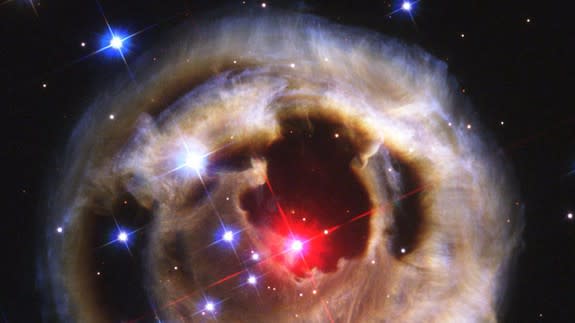Mark your 2022 calendars to watch a star explosion

In five years, people looking up at the night sky might see something very special.
If one prediction is correct, in 2022 (give or take a year), two stars merging and exploding 1,800 light-years from Earth will become an incredibly bright light in the constellation Cygnus, rivaling the brightness of some of the most luminous stars in the sky.
SEE ALSO: The most luminous distant galaxy ever found shelters universe's first stars
"It’s a one-in-a-million chance that you can predict an explosion," astronomer Larry Molnar, one of the scientists behind the prediction, said in a statement.
"It’s never been done before."
Molnar and his team have been monitoring the KIC 9832227 star system since 2013.
Through the course of their observations, he and his colleagues were able to determine that KIC 9832227 is actually a binary — two stars orbiting one another — and not just a single pulsing star in the night sky.
Molnar's research assistant Daniel Van Noord at the time figured out that the star system was a "contact binary" — meaning that the two stars that make up the system are actually enveloped by the same atmosphere.
Because these stars seem to be spiraling in toward one another, Molnar predicts that they will merge in a stellar explosion known as a "red nova."
Molnar is basing his theory, in part, on observations of another red nova — known as V1309 Scorpii — which exploded in 2008. That star system was also a contact binary with the stars spiraling in toward each other.
"Bottom line is we really think our merging star hypothesis should be taken seriously right now and we should be using the next few years to study this intensely so that if it does blow up we will know what led to that explosion," said Molnar.
Predicting this kind of stellar explosion isn't an exact science, and it's still unclear whether the KIC 9832227 system is going to explode as a red nova along the timescale Molnar is suggesting.
"Perhaps the greatest uncertainty with the approach is that it has never been tested before," astronomer Dan Milisavljevic, who is not associated with the team that made the prediction, told Mashable via email.
"Molnar is using a single example to make a prediction about what may be a totally different type of system. There is no guarantee that KIC 9832227 will yield the same fireworks that V1309 Sco [Scorpii] did."
That said, according to Milisavljevic, this prediction presents an amazing opportunity for any interested observer to put to the test.
"The best science comes from theories that make predictions that can be tested, and it doesn't get any better than this," Milisavljevic, who works at the Harvard-Smithsonian Center for Astrophysics, added.
In reality, the star explosion predicted for the 2020s has already occurred. Because the stars in the contact binary are 1,800 light-years from Earth, news of their explosion will take at least 1,800 years to reach our little planet. But we can wait a little longer to find out.
"Billions of people can potentially look up towards the constellation Cygnus in 2022 and verify whether or not Molnar's gutsy prediction is correct," Milisavljevic said. "The universe will still be around then — hopefully we will be too!"
